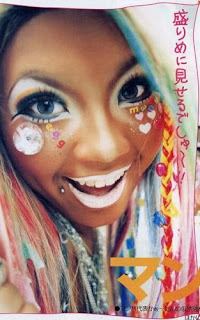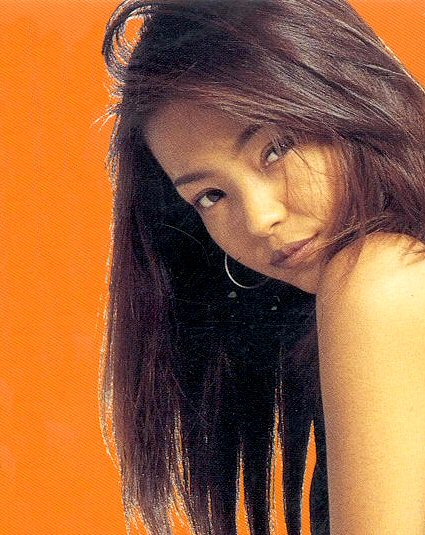Featured
- Get link
- X
- Other Apps
Ganguro – Japanese girls - forgotten subculture
 |
| Ganguro girl style |
Ganguro (顔 黒) is just one of the subgroups derived from Gyaru and translated from Japanese, where the first kanji character 顔 "Gan" means "Face" and the second 黒 "kuro" means "black" - "black face". Where did this subculture come from? Some say that it was started by the love of Japanese women for black idols from America and the desire to imitate their image. Back then, Japan was dominated by hairdressing salons advertising new hairstyles called "buraku" (black) or "afuro" (afro), and in shops dark foundations and self-tanners were sold. Girls following this style would regularly visit the tan salons or simply put on dark makeup to keep the skin very dark and their hair dyed very light blonde. There were almost theatrical props attached to the hair, such as necklaces, hairpins or artificial tropical flowers strung on bracelets. Ganguro also used coloured contact lenses, temporary tattoos and cowboy hats. The dark skin was highlighted with pearly eyeshadow and lipstick, which was painted with thick white rings around the eyes and on the lips. Additionally, the eyes were emphasized with dark eyeliner and false eyelashes (2). Their attire was distinctive; platform shoes or boots, purikura (read this article HERE) and cell phones. Ganguro Girls reigned supreme in metropolitan areas of Tokyo, in Shibuya and Ikebukuro districts.
Please have a look at the Ganguro girl make-up video 👇💗
 |
| Namie Amuro popular Japanese singer |
Some people think the style started in the mid 90's with the rise of a certain tanned Okinawan singer (Japanese island) - Namie Amuro. Her musical talent and dancing skills combined with her characteristic stage presence have spread all over the world. It was probably the first Japanese sensation in the 90's and Namie Amuro was the best in the entire Japanese music industry. As the most recognizable singer and model, especially when she performed with darkened makeup on her face, she became a popular idol of teenage girls. Interestingly, some social and cultural scholars speculate that Ai Iijima had a great influence on the Ganguro girls. This is quite a controversial theory, because Ai Iijima was known as an adult movie star 😉. She had light brown hair and wore colourful, very provocative clothes. At a time when cosmetic giants like Shiseido were rampaging on skin-lightening products, Ai Iijima flaunted a deep tan (3).
 |
| Ganguro Girls |
The third and last very likely reason for
the emergence of this fashion subculture was the desire to break free from the
rigid norms that were (and still are) in force in Japan, where special rules of
dress, hairstyle (especially in schools) and behaviour apply. The entire Gyaru
subculture, including Ganguro, was supposed to be a protest against social
norms and also against the common stereotype that women's skin should be as
light as possible.
The Ganguro subculture is almost completely
forgotten. Gyaru's style has changed completely, as have preferences and all
followers of this style have opted for a more contemporary look.
 |
| Ganguro girl in bikini |
If you liked it, please like, share or
leave a comment. I am happy to answer any question.
* The pictures of Ganguro Girls were taken from Japanese Egg Magazine, July 2004.
References:
(1) Suzuki, K., 2019. Gyaru: The Brazen Fashion Rebellion of 90s Japan. [online] Unseen Japan. Available at: <https://unseenjapan.com/gyaru-culture/> [Accessed 1 April 2021].
(2) Kinsella S., 2005. Black Faces, Witches, and Racism against Girls. In: Miller L., Bardsley J. (eds) Bad Girls of Japan. Palgrave Macmillan, New York. https://doi.org/10.1057/9781403977120_10> [Accessed 1 April 2021].
(3) Liu, X., 2009. Ganguro in Japanese Youth Culture: Self-Identity in Cultural Conflict. Japanese Studies Review, [online] XXII, pp.57-70. Available at: <https://asian.fiu.edu/projects-and-grants/japan-studies-review/journal-archive/volume-xiii-2009/liu-ganguro-in-japanese-youth-culture.pdf> [Accessed 1 April 2021].
W czasach mojej młodości fascynowałam
się pewna subkultura panująca w Japonii a chodzi tu dokładnie o Ganguro. Pewnie
Ci którzy spotykają się z tematem po raz pierwszy zastanawiają się co to może być?
Ganguro wiąże się z pewnym stylem ubierania się który nazywa się Gyaru (ギャル). Gyaru pochodzi od słowa
„Gal” który jest ogólnym terminem opisującym tą szczególną modową subkulturę, która
od lat 80-tych nieustannie się zmieniała i dzieliła na kolejne podgrupy. Ogólnie
nie wiadomo, kiedy styl Gyaru miał swój początek, ale odnosi się do dziewczyn, które
farbowały swoje włosy na jasny kolor, nosiły ciężki makijaż, prowokacyjne
ubrania i odpowiednie wyzywające zachowanie (1).
Ganguro (顔黒)jest
właśnie jedną z podgrup wywodzących się od Gyaru i w tłumaczeniu z języka
Japońskiego, gdzie pierwszy znak kanji 顔 „Gan” oznacza „Twarz” a drugi 黒 „kuro” oznacza „czarny”
– „czarna twarz”. Skąd się wzięła ta subkultura? Jedni twierdzą, że
zapoczątkowała ją miłość Japonek do czarnoskórych idoli z Ameryki i chęć
naśladowania ich wizerunku. Wówczas w Japonii
królowały salony fryzjerskie reklamujące nowe fryzury nazywane „buraku” (black)
albo „afuro” (afro) a w supermarketach sprzedawano ciemne podkłady i samoopalacze.
Dziewczęta podążające za tym stylem regularnie odwiedzały solarium lub po
prostu nakładały ciemny makijaż, aby skóra miała bardzo ciemny kolor a włosy
farbowane były na bardzo jasny blond. Do włosów przyczepione były niemal
teatralne rekwizyty tj. naszyjniki, spinki do włosów czy sztuczne kwiaty
tropikalne nawleczone na bransoletki. Ganguro używały również kolorowe soczewki
kontaktowe, tymczasowe tatuaże czy kowbojskie kapelusze. Ciemną skórę
podkreślono perłowym cieniem do powiek i szminką, którą malowano grubymi
białymi pierścieniami wokół oczy i na ustach. Dodatkowo oczy były podkreślane
ciemnym eyelinerem i sztucznymi rzęsami (2). Ich ubiór był charakterystyczny; buty na
platformach albo kozaki, purikura (możesz przeczytać ten artykuł TUTAJ) i
telefony komórkowe. Dziewczyny Ganguro królowały w obszarach metropolitarnych
Tokyo, w dzielnicach takich jak Shibuya czy Ikebukuro.
Niektórzy sądzą,
że styl ten powstał w połowie lat 90-tych razem ze wzrostem popularności pewnej
opalonej piosenkarki z Okinawy (wyspa Japońska) – Namie Amuro. Talent muzyczny Namie Amuro oraz jej umiejętności
taneczne połączone z jej charakterystyczną prezencją sceniczną obiegły cały świat.
To była prawdopodobnie pierwsza Japońska sensacja w lata 90-tych i Namie Amuro
była najlepsza w całym Japońskim przemyśle muzycznym. Jako najbardziej rozpoznawalna
piosenkarka i modelka, szczególnie wtedy, kiedy występowała z przyciemnioną
makijażem twarzą, stała się popularną idolką nastoletnich dziewcząt. Co również
ciekawe, niektórzy badacze nauk społecznych i kulturowych spekulują, że Ai
Iijima miała wielki wpływ na dziewczyny Ganguro. To dość kontrowersyjna teoria,
bo Ai Iijima była znana jako gwiazda filmów dla dorosłych 😉. Miała ona rozjaśnione
brązowe włosy i nosiła kolorowa, bardzo wyzywające ubrania. W momencie, kiedy takie
kosmetyczne giganty jak Shiseido zaczynały szał na produkty rozjaśniające
skórę, Ai Iijima obnosiła się z głęboką opalenizną (3).
Trzecim i ostatnim bardzo prawdopodobnym powodem powstania tej modowej subkultury była chęć uwolnienia się ze sztywnych norm obowiązujących w Japonii, gdzie obowiązują szczególne zasady ubioru, nakazy co do fryzury (szczególnie w placówkach szkolnych) i zachowania. Cała subkultura Gyaru a w tym i Ganguro miała być protestem przeciwko normom społecznym a także przeciwko powszechnemu stereotypowi, że kobieca skóra powinna być tak jasna jak to tylko możliwe.
Subkultura gyaru, w tym i Ganguro prawie całkowicie
odeszła w zapomnienie. Styl Gyaru zmienił się całkowicie, tak samo jak
preferencje a wszelcy naśladowcy tego stylu postawili na bardziej współczesny
wygląd.
Wielu z was powie, że to kicz i
przerysowanie, powód do śmiechu, ale dla tych dziewcząt był to sposób na niemy
protest, na bunt i sprzeciw, a dla obserwatorów, w tym i mnie niezwykłe
zjawisko socio-kulturalne.
Jeśli wam się podobało, proszę polubcie,
udostępnijcie albo zostawcie komentarz. Chętnie odpowiem na każde pytanie.
Referencje
(1) Suzuki, K., 2019. Gyaru: The Brazen Fashion Rebellion of 90s Japan. [online] Unseen Japan. Available at: <https://unseenjapan.com/gyaru-culture/> [Accessed 1 April 2021].
(2) Kinsella S., 2005. Black Faces, Witches, and Racism against Girls. In: Miller L., Bardsley J. (eds) Bad Girls of Japan. Palgrave Macmillan, New York. https://doi.org/10.1057/9781403977120_10> [Accessed 1 April 2021].
(3) Liu, X., 2009. Ganguro in Japanese Youth Culture: Self-Identity in Cultural Conflict. Japanese Studies Review, [online] XXII, pp.57-70. Available at: <https://asian.fiu.edu/projects-and-grants/japan-studies-review/journal-archive/volume-xiii-2009/liu-ganguro-in-japanese-youth-culture.pdf> [Accessed 1 April 2021].
- Get link
- X
- Other Apps

Comments
Post a Comment